Online Services Essay: Evaluating Pros, Cons, and Security Challenges
VerifiedAdded on 2023/01/11
|10
|2992
|20
Essay
AI Summary
This essay examines the multifaceted impact of online services, contrasting them with offline alternatives for both individuals and businesses. It explores the benefits of online communication, global reach, and cost-effectiveness, while also addressing critical security challenges such as data breaches, cyber threats, and privacy concerns. The essay delves into the distinctions between websites and blogs, highlighting their respective roles in online presence and communication. It also discusses the importance of security measures, including strong passwords, awareness of data privacy, and vigilance against suspicious activities. The analysis underscores the need for a balanced approach, integrating online and offline strategies to maximize benefits while mitigating risks.

PROJECT
Paraphrase This Document
Need a fresh take? Get an instant paraphrase of this document with our AI Paraphraser

TABLE OF CONTENTS
ESSAY.............................................................................................................................................3
REFERNCES.................................................................................................................................10
ESSAY.............................................................................................................................................3
REFERNCES.................................................................................................................................10
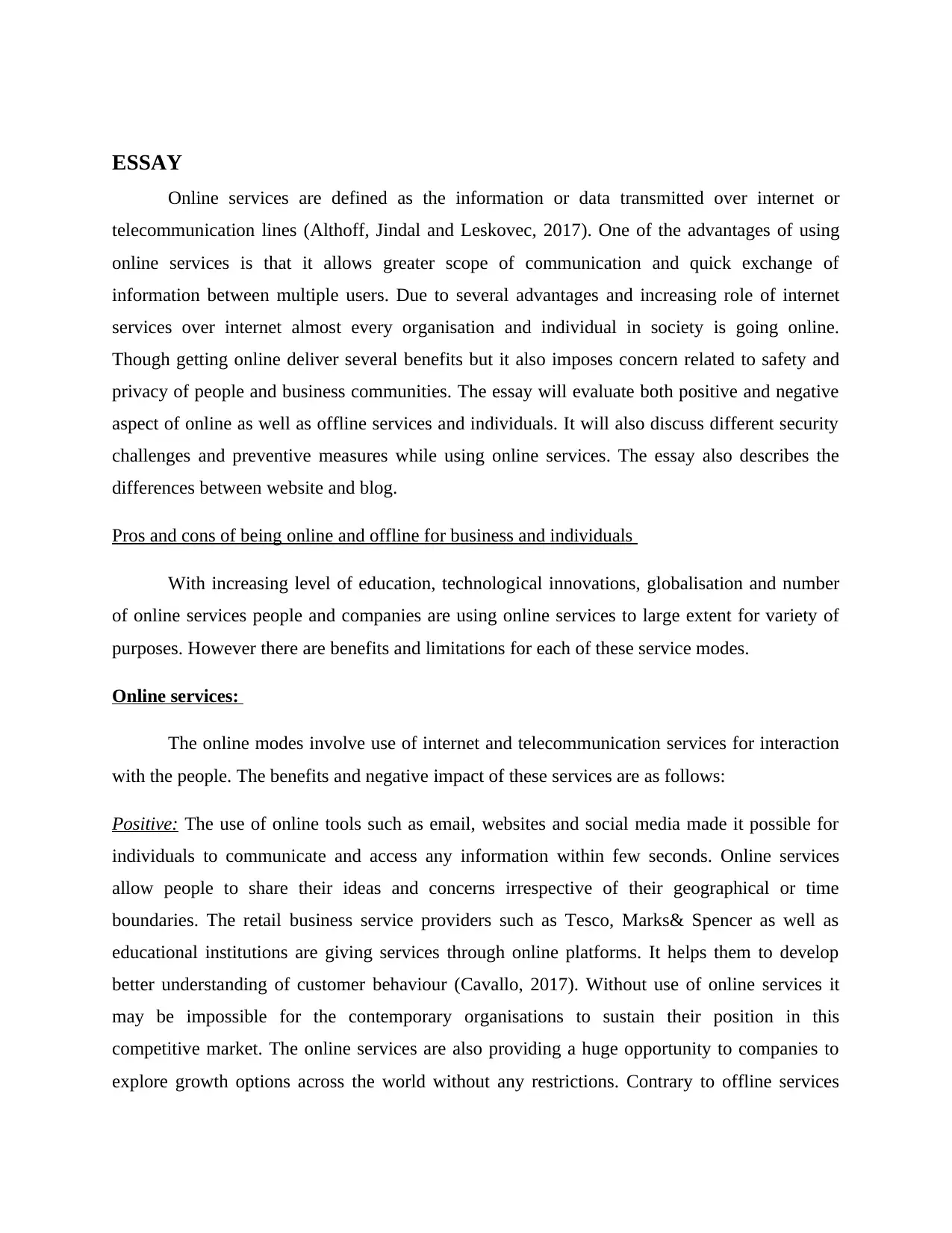
ESSAY
Online services are defined as the information or data transmitted over internet or
telecommunication lines (Althoff, Jindal and Leskovec, 2017). One of the advantages of using
online services is that it allows greater scope of communication and quick exchange of
information between multiple users. Due to several advantages and increasing role of internet
services over internet almost every organisation and individual in society is going online.
Though getting online deliver several benefits but it also imposes concern related to safety and
privacy of people and business communities. The essay will evaluate both positive and negative
aspect of online as well as offline services and individuals. It will also discuss different security
challenges and preventive measures while using online services. The essay also describes the
differences between website and blog.
Pros and cons of being online and offline for business and individuals
With increasing level of education, technological innovations, globalisation and number
of online services people and companies are using online services to large extent for variety of
purposes. However there are benefits and limitations for each of these service modes.
Online services:
The online modes involve use of internet and telecommunication services for interaction
with the people. The benefits and negative impact of these services are as follows:
Positive: The use of online tools such as email, websites and social media made it possible for
individuals to communicate and access any information within few seconds. Online services
allow people to share their ideas and concerns irrespective of their geographical or time
boundaries. The retail business service providers such as Tesco, Marks& Spencer as well as
educational institutions are giving services through online platforms. It helps them to develop
better understanding of customer behaviour (Cavallo, 2017). Without use of online services it
may be impossible for the contemporary organisations to sustain their position in this
competitive market. The online services are also providing a huge opportunity to companies to
explore growth options across the world without any restrictions. Contrary to offline services
Online services are defined as the information or data transmitted over internet or
telecommunication lines (Althoff, Jindal and Leskovec, 2017). One of the advantages of using
online services is that it allows greater scope of communication and quick exchange of
information between multiple users. Due to several advantages and increasing role of internet
services over internet almost every organisation and individual in society is going online.
Though getting online deliver several benefits but it also imposes concern related to safety and
privacy of people and business communities. The essay will evaluate both positive and negative
aspect of online as well as offline services and individuals. It will also discuss different security
challenges and preventive measures while using online services. The essay also describes the
differences between website and blog.
Pros and cons of being online and offline for business and individuals
With increasing level of education, technological innovations, globalisation and number
of online services people and companies are using online services to large extent for variety of
purposes. However there are benefits and limitations for each of these service modes.
Online services:
The online modes involve use of internet and telecommunication services for interaction
with the people. The benefits and negative impact of these services are as follows:
Positive: The use of online tools such as email, websites and social media made it possible for
individuals to communicate and access any information within few seconds. Online services
allow people to share their ideas and concerns irrespective of their geographical or time
boundaries. The retail business service providers such as Tesco, Marks& Spencer as well as
educational institutions are giving services through online platforms. It helps them to develop
better understanding of customer behaviour (Cavallo, 2017). Without use of online services it
may be impossible for the contemporary organisations to sustain their position in this
competitive market. The online services are also providing a huge opportunity to companies to
explore growth options across the world without any restrictions. Contrary to offline services
⊘ This is a preview!⊘
Do you want full access?
Subscribe today to unlock all pages.

Trusted by 1+ million students worldwide
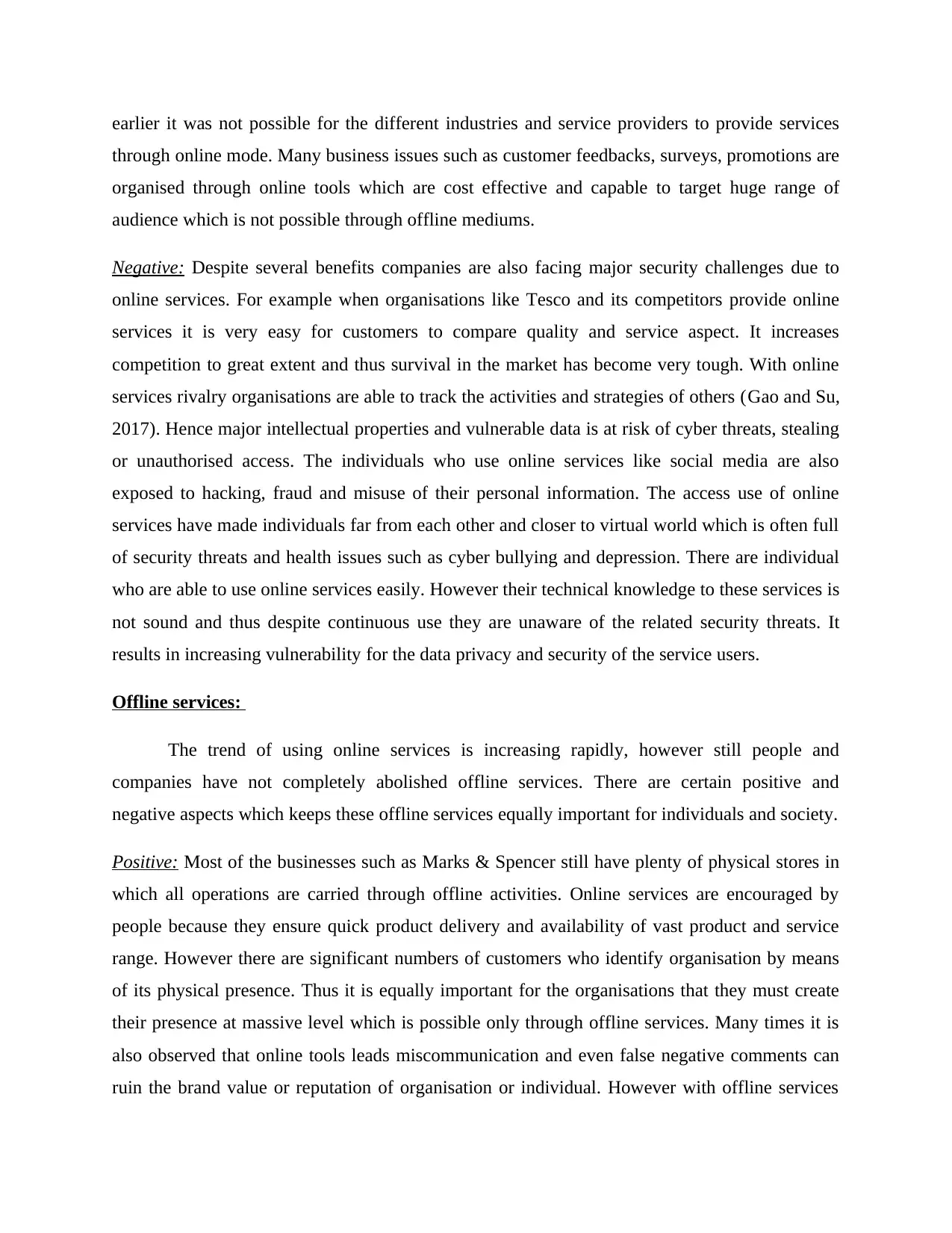
earlier it was not possible for the different industries and service providers to provide services
through online mode. Many business issues such as customer feedbacks, surveys, promotions are
organised through online tools which are cost effective and capable to target huge range of
audience which is not possible through offline mediums.
Negative: Despite several benefits companies are also facing major security challenges due to
online services. For example when organisations like Tesco and its competitors provide online
services it is very easy for customers to compare quality and service aspect. It increases
competition to great extent and thus survival in the market has become very tough. With online
services rivalry organisations are able to track the activities and strategies of others (Gao and Su,
2017). Hence major intellectual properties and vulnerable data is at risk of cyber threats, stealing
or unauthorised access. The individuals who use online services like social media are also
exposed to hacking, fraud and misuse of their personal information. The access use of online
services have made individuals far from each other and closer to virtual world which is often full
of security threats and health issues such as cyber bullying and depression. There are individual
who are able to use online services easily. However their technical knowledge to these services is
not sound and thus despite continuous use they are unaware of the related security threats. It
results in increasing vulnerability for the data privacy and security of the service users.
Offline services:
The trend of using online services is increasing rapidly, however still people and
companies have not completely abolished offline services. There are certain positive and
negative aspects which keeps these offline services equally important for individuals and society.
Positive: Most of the businesses such as Marks & Spencer still have plenty of physical stores in
which all operations are carried through offline activities. Online services are encouraged by
people because they ensure quick product delivery and availability of vast product and service
range. However there are significant numbers of customers who identify organisation by means
of its physical presence. Thus it is equally important for the organisations that they must create
their presence at massive level which is possible only through offline services. Many times it is
also observed that online tools leads miscommunication and even false negative comments can
ruin the brand value or reputation of organisation or individual. However with offline services
through online mode. Many business issues such as customer feedbacks, surveys, promotions are
organised through online tools which are cost effective and capable to target huge range of
audience which is not possible through offline mediums.
Negative: Despite several benefits companies are also facing major security challenges due to
online services. For example when organisations like Tesco and its competitors provide online
services it is very easy for customers to compare quality and service aspect. It increases
competition to great extent and thus survival in the market has become very tough. With online
services rivalry organisations are able to track the activities and strategies of others (Gao and Su,
2017). Hence major intellectual properties and vulnerable data is at risk of cyber threats, stealing
or unauthorised access. The individuals who use online services like social media are also
exposed to hacking, fraud and misuse of their personal information. The access use of online
services have made individuals far from each other and closer to virtual world which is often full
of security threats and health issues such as cyber bullying and depression. There are individual
who are able to use online services easily. However their technical knowledge to these services is
not sound and thus despite continuous use they are unaware of the related security threats. It
results in increasing vulnerability for the data privacy and security of the service users.
Offline services:
The trend of using online services is increasing rapidly, however still people and
companies have not completely abolished offline services. There are certain positive and
negative aspects which keeps these offline services equally important for individuals and society.
Positive: Most of the businesses such as Marks & Spencer still have plenty of physical stores in
which all operations are carried through offline activities. Online services are encouraged by
people because they ensure quick product delivery and availability of vast product and service
range. However there are significant numbers of customers who identify organisation by means
of its physical presence. Thus it is equally important for the organisations that they must create
their presence at massive level which is possible only through offline services. Many times it is
also observed that online tools leads miscommunication and even false negative comments can
ruin the brand value or reputation of organisation or individual. However with offline services
Paraphrase This Document
Need a fresh take? Get an instant paraphrase of this document with our AI Paraphraser
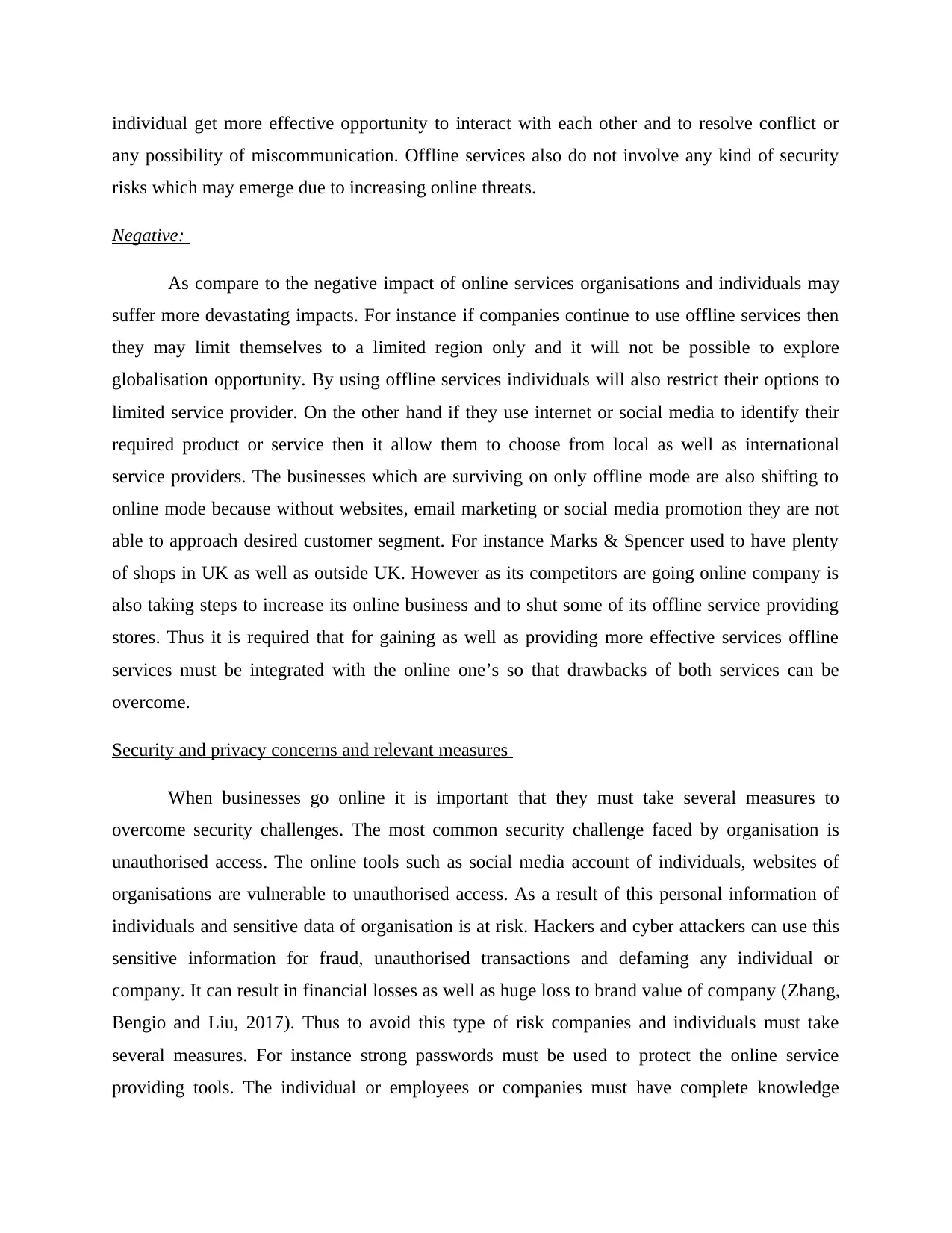
individual get more effective opportunity to interact with each other and to resolve conflict or
any possibility of miscommunication. Offline services also do not involve any kind of security
risks which may emerge due to increasing online threats.
Negative:
As compare to the negative impact of online services organisations and individuals may
suffer more devastating impacts. For instance if companies continue to use offline services then
they may limit themselves to a limited region only and it will not be possible to explore
globalisation opportunity. By using offline services individuals will also restrict their options to
limited service provider. On the other hand if they use internet or social media to identify their
required product or service then it allow them to choose from local as well as international
service providers. The businesses which are surviving on only offline mode are also shifting to
online mode because without websites, email marketing or social media promotion they are not
able to approach desired customer segment. For instance Marks & Spencer used to have plenty
of shops in UK as well as outside UK. However as its competitors are going online company is
also taking steps to increase its online business and to shut some of its offline service providing
stores. Thus it is required that for gaining as well as providing more effective services offline
services must be integrated with the online one’s so that drawbacks of both services can be
overcome.
Security and privacy concerns and relevant measures
When businesses go online it is important that they must take several measures to
overcome security challenges. The most common security challenge faced by organisation is
unauthorised access. The online tools such as social media account of individuals, websites of
organisations are vulnerable to unauthorised access. As a result of this personal information of
individuals and sensitive data of organisation is at risk. Hackers and cyber attackers can use this
sensitive information for fraud, unauthorised transactions and defaming any individual or
company. It can result in financial losses as well as huge loss to brand value of company (Zhang,
Bengio and Liu, 2017). Thus to avoid this type of risk companies and individuals must take
several measures. For instance strong passwords must be used to protect the online service
providing tools. The individual or employees or companies must have complete knowledge
any possibility of miscommunication. Offline services also do not involve any kind of security
risks which may emerge due to increasing online threats.
Negative:
As compare to the negative impact of online services organisations and individuals may
suffer more devastating impacts. For instance if companies continue to use offline services then
they may limit themselves to a limited region only and it will not be possible to explore
globalisation opportunity. By using offline services individuals will also restrict their options to
limited service provider. On the other hand if they use internet or social media to identify their
required product or service then it allow them to choose from local as well as international
service providers. The businesses which are surviving on only offline mode are also shifting to
online mode because without websites, email marketing or social media promotion they are not
able to approach desired customer segment. For instance Marks & Spencer used to have plenty
of shops in UK as well as outside UK. However as its competitors are going online company is
also taking steps to increase its online business and to shut some of its offline service providing
stores. Thus it is required that for gaining as well as providing more effective services offline
services must be integrated with the online one’s so that drawbacks of both services can be
overcome.
Security and privacy concerns and relevant measures
When businesses go online it is important that they must take several measures to
overcome security challenges. The most common security challenge faced by organisation is
unauthorised access. The online tools such as social media account of individuals, websites of
organisations are vulnerable to unauthorised access. As a result of this personal information of
individuals and sensitive data of organisation is at risk. Hackers and cyber attackers can use this
sensitive information for fraud, unauthorised transactions and defaming any individual or
company. It can result in financial losses as well as huge loss to brand value of company (Zhang,
Bengio and Liu, 2017). Thus to avoid this type of risk companies and individuals must take
several measures. For instance strong passwords must be used to protect the online service
providing tools. The individual or employees or companies must have complete knowledge
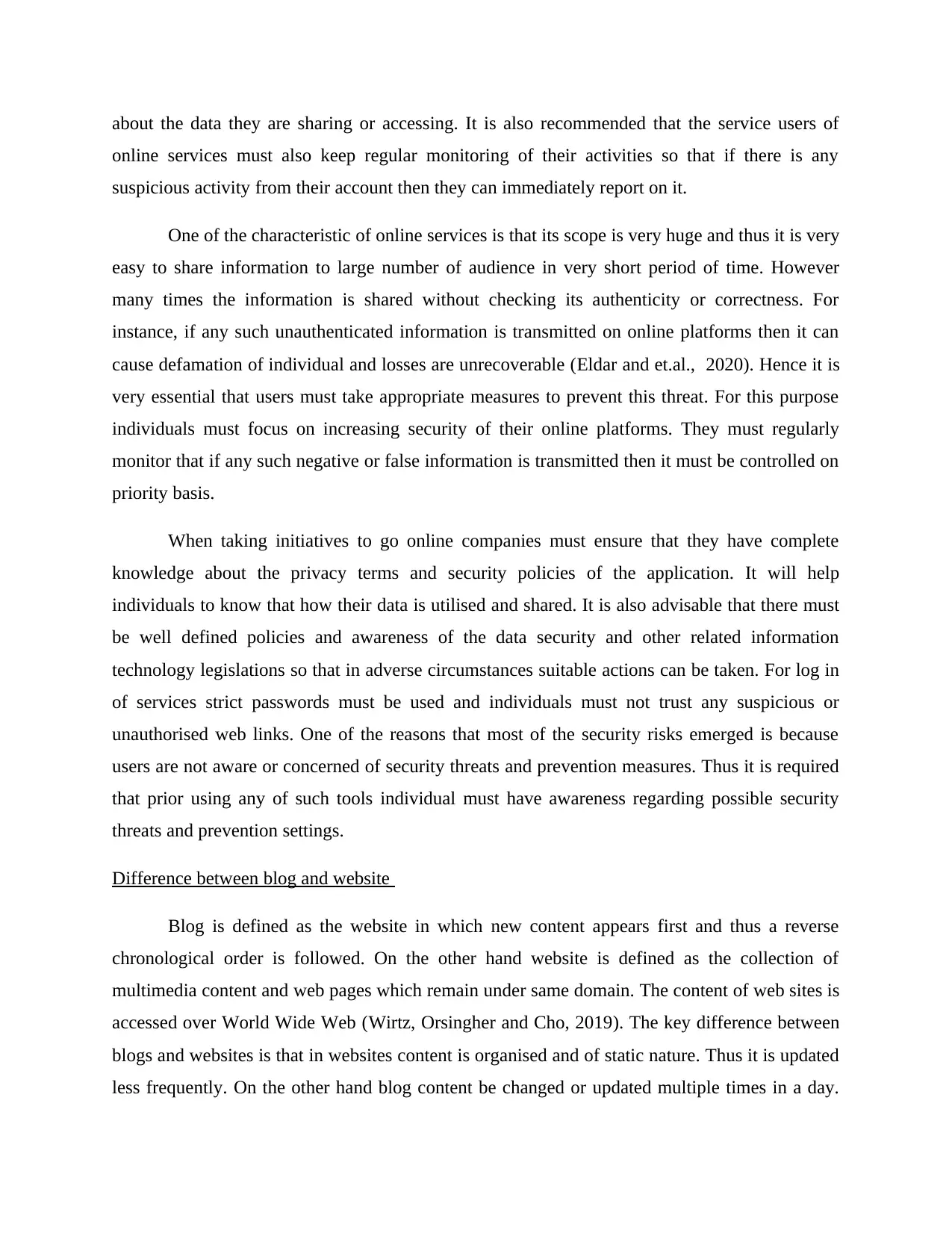
about the data they are sharing or accessing. It is also recommended that the service users of
online services must also keep regular monitoring of their activities so that if there is any
suspicious activity from their account then they can immediately report on it.
One of the characteristic of online services is that its scope is very huge and thus it is very
easy to share information to large number of audience in very short period of time. However
many times the information is shared without checking its authenticity or correctness. For
instance, if any such unauthenticated information is transmitted on online platforms then it can
cause defamation of individual and losses are unrecoverable (Eldar and et.al., 2020). Hence it is
very essential that users must take appropriate measures to prevent this threat. For this purpose
individuals must focus on increasing security of their online platforms. They must regularly
monitor that if any such negative or false information is transmitted then it must be controlled on
priority basis.
When taking initiatives to go online companies must ensure that they have complete
knowledge about the privacy terms and security policies of the application. It will help
individuals to know that how their data is utilised and shared. It is also advisable that there must
be well defined policies and awareness of the data security and other related information
technology legislations so that in adverse circumstances suitable actions can be taken. For log in
of services strict passwords must be used and individuals must not trust any suspicious or
unauthorised web links. One of the reasons that most of the security risks emerged is because
users are not aware or concerned of security threats and prevention measures. Thus it is required
that prior using any of such tools individual must have awareness regarding possible security
threats and prevention settings.
Difference between blog and website
Blog is defined as the website in which new content appears first and thus a reverse
chronological order is followed. On the other hand website is defined as the collection of
multimedia content and web pages which remain under same domain. The content of web sites is
accessed over World Wide Web (Wirtz, Orsingher and Cho, 2019). The key difference between
blogs and websites is that in websites content is organised and of static nature. Thus it is updated
less frequently. On the other hand blog content be changed or updated multiple times in a day.
online services must also keep regular monitoring of their activities so that if there is any
suspicious activity from their account then they can immediately report on it.
One of the characteristic of online services is that its scope is very huge and thus it is very
easy to share information to large number of audience in very short period of time. However
many times the information is shared without checking its authenticity or correctness. For
instance, if any such unauthenticated information is transmitted on online platforms then it can
cause defamation of individual and losses are unrecoverable (Eldar and et.al., 2020). Hence it is
very essential that users must take appropriate measures to prevent this threat. For this purpose
individuals must focus on increasing security of their online platforms. They must regularly
monitor that if any such negative or false information is transmitted then it must be controlled on
priority basis.
When taking initiatives to go online companies must ensure that they have complete
knowledge about the privacy terms and security policies of the application. It will help
individuals to know that how their data is utilised and shared. It is also advisable that there must
be well defined policies and awareness of the data security and other related information
technology legislations so that in adverse circumstances suitable actions can be taken. For log in
of services strict passwords must be used and individuals must not trust any suspicious or
unauthorised web links. One of the reasons that most of the security risks emerged is because
users are not aware or concerned of security threats and prevention measures. Thus it is required
that prior using any of such tools individual must have awareness regarding possible security
threats and prevention settings.
Difference between blog and website
Blog is defined as the website in which new content appears first and thus a reverse
chronological order is followed. On the other hand website is defined as the collection of
multimedia content and web pages which remain under same domain. The content of web sites is
accessed over World Wide Web (Wirtz, Orsingher and Cho, 2019). The key difference between
blogs and websites is that in websites content is organised and of static nature. Thus it is updated
less frequently. On the other hand blog content be changed or updated multiple times in a day.
⊘ This is a preview!⊘
Do you want full access?
Subscribe today to unlock all pages.

Trusted by 1+ million students worldwide
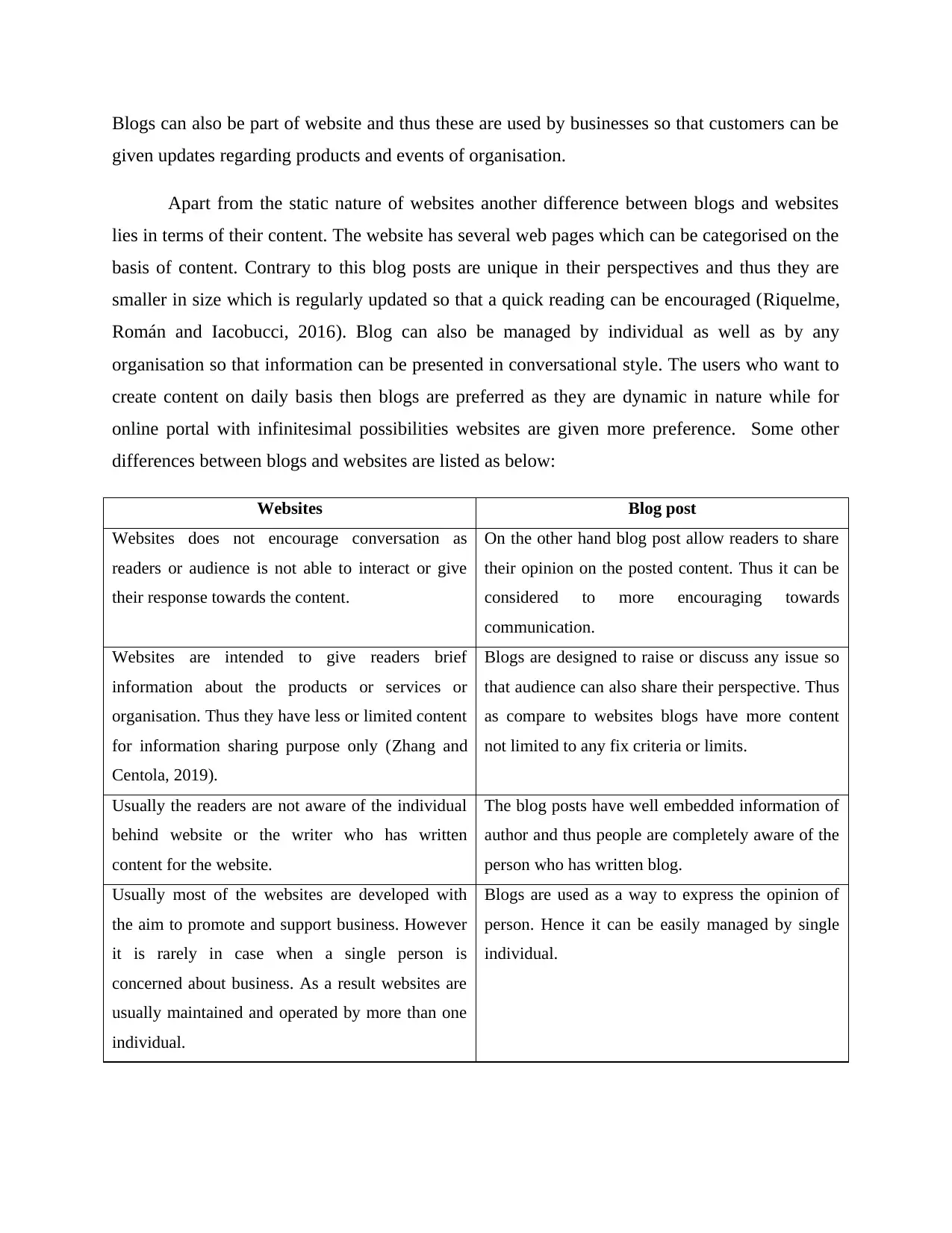
Blogs can also be part of website and thus these are used by businesses so that customers can be
given updates regarding products and events of organisation.
Apart from the static nature of websites another difference between blogs and websites
lies in terms of their content. The website has several web pages which can be categorised on the
basis of content. Contrary to this blog posts are unique in their perspectives and thus they are
smaller in size which is regularly updated so that a quick reading can be encouraged (Riquelme,
Román and Iacobucci, 2016). Blog can also be managed by individual as well as by any
organisation so that information can be presented in conversational style. The users who want to
create content on daily basis then blogs are preferred as they are dynamic in nature while for
online portal with infinitesimal possibilities websites are given more preference. Some other
differences between blogs and websites are listed as below:
Websites Blog post
Websites does not encourage conversation as
readers or audience is not able to interact or give
their response towards the content.
On the other hand blog post allow readers to share
their opinion on the posted content. Thus it can be
considered to more encouraging towards
communication.
Websites are intended to give readers brief
information about the products or services or
organisation. Thus they have less or limited content
for information sharing purpose only (Zhang and
Centola, 2019).
Blogs are designed to raise or discuss any issue so
that audience can also share their perspective. Thus
as compare to websites blogs have more content
not limited to any fix criteria or limits.
Usually the readers are not aware of the individual
behind website or the writer who has written
content for the website.
The blog posts have well embedded information of
author and thus people are completely aware of the
person who has written blog.
Usually most of the websites are developed with
the aim to promote and support business. However
it is rarely in case when a single person is
concerned about business. As a result websites are
usually maintained and operated by more than one
individual.
Blogs are used as a way to express the opinion of
person. Hence it can be easily managed by single
individual.
given updates regarding products and events of organisation.
Apart from the static nature of websites another difference between blogs and websites
lies in terms of their content. The website has several web pages which can be categorised on the
basis of content. Contrary to this blog posts are unique in their perspectives and thus they are
smaller in size which is regularly updated so that a quick reading can be encouraged (Riquelme,
Román and Iacobucci, 2016). Blog can also be managed by individual as well as by any
organisation so that information can be presented in conversational style. The users who want to
create content on daily basis then blogs are preferred as they are dynamic in nature while for
online portal with infinitesimal possibilities websites are given more preference. Some other
differences between blogs and websites are listed as below:
Websites Blog post
Websites does not encourage conversation as
readers or audience is not able to interact or give
their response towards the content.
On the other hand blog post allow readers to share
their opinion on the posted content. Thus it can be
considered to more encouraging towards
communication.
Websites are intended to give readers brief
information about the products or services or
organisation. Thus they have less or limited content
for information sharing purpose only (Zhang and
Centola, 2019).
Blogs are designed to raise or discuss any issue so
that audience can also share their perspective. Thus
as compare to websites blogs have more content
not limited to any fix criteria or limits.
Usually the readers are not aware of the individual
behind website or the writer who has written
content for the website.
The blog posts have well embedded information of
author and thus people are completely aware of the
person who has written blog.
Usually most of the websites are developed with
the aim to promote and support business. However
it is rarely in case when a single person is
concerned about business. As a result websites are
usually maintained and operated by more than one
individual.
Blogs are used as a way to express the opinion of
person. Hence it can be easily managed by single
individual.
Paraphrase This Document
Need a fresh take? Get an instant paraphrase of this document with our AI Paraphraser
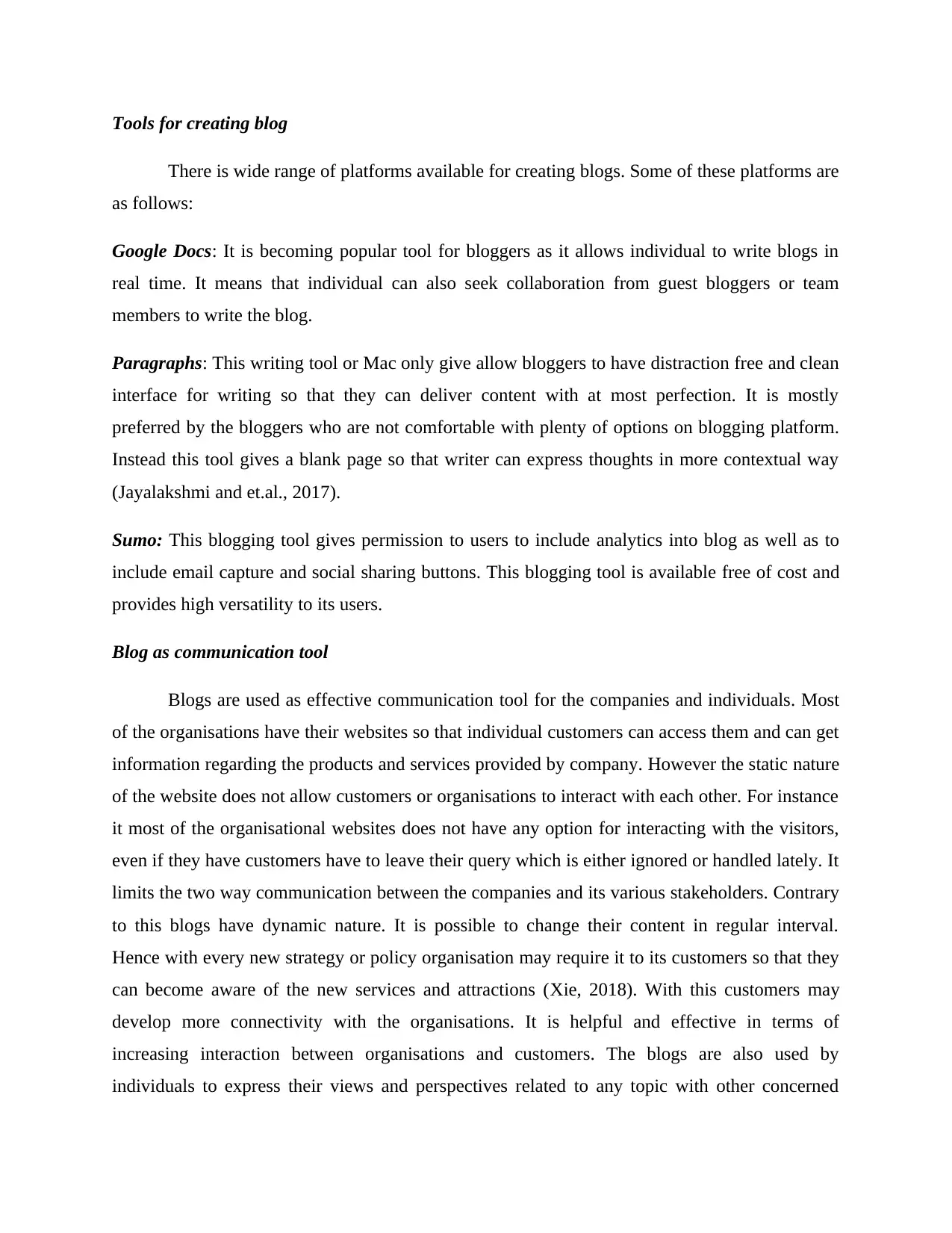
Tools for creating blog
There is wide range of platforms available for creating blogs. Some of these platforms are
as follows:
Google Docs: It is becoming popular tool for bloggers as it allows individual to write blogs in
real time. It means that individual can also seek collaboration from guest bloggers or team
members to write the blog.
Paragraphs: This writing tool or Mac only give allow bloggers to have distraction free and clean
interface for writing so that they can deliver content with at most perfection. It is mostly
preferred by the bloggers who are not comfortable with plenty of options on blogging platform.
Instead this tool gives a blank page so that writer can express thoughts in more contextual way
(Jayalakshmi and et.al., 2017).
Sumo: This blogging tool gives permission to users to include analytics into blog as well as to
include email capture and social sharing buttons. This blogging tool is available free of cost and
provides high versatility to its users.
Blog as communication tool
Blogs are used as effective communication tool for the companies and individuals. Most
of the organisations have their websites so that individual customers can access them and can get
information regarding the products and services provided by company. However the static nature
of the website does not allow customers or organisations to interact with each other. For instance
it most of the organisational websites does not have any option for interacting with the visitors,
even if they have customers have to leave their query which is either ignored or handled lately. It
limits the two way communication between the companies and its various stakeholders. Contrary
to this blogs have dynamic nature. It is possible to change their content in regular interval.
Hence with every new strategy or policy organisation may require it to its customers so that they
can become aware of the new services and attractions (Xie, 2018). With this customers may
develop more connectivity with the organisations. It is helpful and effective in terms of
increasing interaction between organisations and customers. The blogs are also used by
individuals to express their views and perspectives related to any topic with other concerned
There is wide range of platforms available for creating blogs. Some of these platforms are
as follows:
Google Docs: It is becoming popular tool for bloggers as it allows individual to write blogs in
real time. It means that individual can also seek collaboration from guest bloggers or team
members to write the blog.
Paragraphs: This writing tool or Mac only give allow bloggers to have distraction free and clean
interface for writing so that they can deliver content with at most perfection. It is mostly
preferred by the bloggers who are not comfortable with plenty of options on blogging platform.
Instead this tool gives a blank page so that writer can express thoughts in more contextual way
(Jayalakshmi and et.al., 2017).
Sumo: This blogging tool gives permission to users to include analytics into blog as well as to
include email capture and social sharing buttons. This blogging tool is available free of cost and
provides high versatility to its users.
Blog as communication tool
Blogs are used as effective communication tool for the companies and individuals. Most
of the organisations have their websites so that individual customers can access them and can get
information regarding the products and services provided by company. However the static nature
of the website does not allow customers or organisations to interact with each other. For instance
it most of the organisational websites does not have any option for interacting with the visitors,
even if they have customers have to leave their query which is either ignored or handled lately. It
limits the two way communication between the companies and its various stakeholders. Contrary
to this blogs have dynamic nature. It is possible to change their content in regular interval.
Hence with every new strategy or policy organisation may require it to its customers so that they
can become aware of the new services and attractions (Xie, 2018). With this customers may
develop more connectivity with the organisations. It is helpful and effective in terms of
increasing interaction between organisations and customers. The blogs are also used by
individuals to express their views and perspectives related to any topic with other concerned
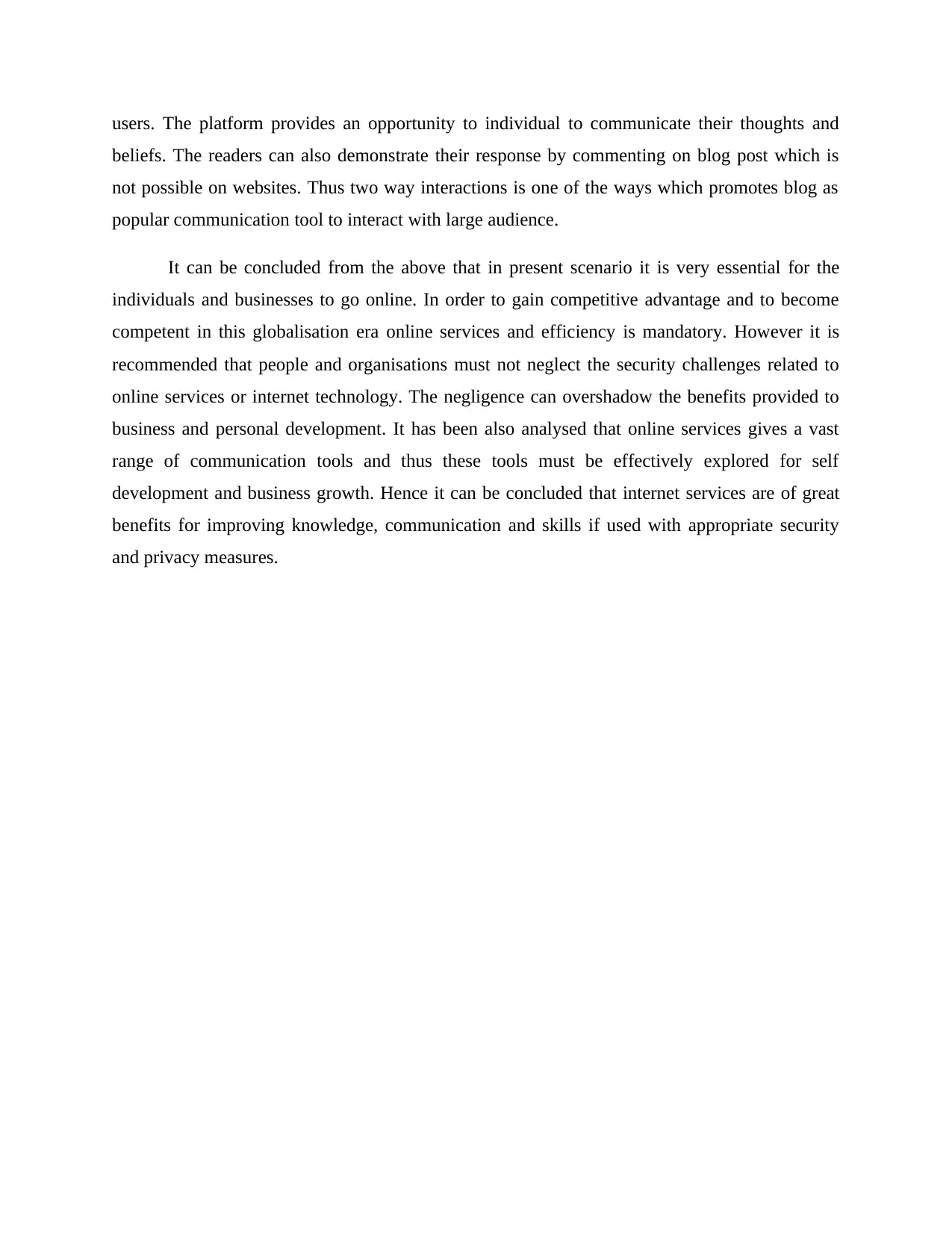
users. The platform provides an opportunity to individual to communicate their thoughts and
beliefs. The readers can also demonstrate their response by commenting on blog post which is
not possible on websites. Thus two way interactions is one of the ways which promotes blog as
popular communication tool to interact with large audience.
It can be concluded from the above that in present scenario it is very essential for the
individuals and businesses to go online. In order to gain competitive advantage and to become
competent in this globalisation era online services and efficiency is mandatory. However it is
recommended that people and organisations must not neglect the security challenges related to
online services or internet technology. The negligence can overshadow the benefits provided to
business and personal development. It has been also analysed that online services gives a vast
range of communication tools and thus these tools must be effectively explored for self
development and business growth. Hence it can be concluded that internet services are of great
benefits for improving knowledge, communication and skills if used with appropriate security
and privacy measures.
beliefs. The readers can also demonstrate their response by commenting on blog post which is
not possible on websites. Thus two way interactions is one of the ways which promotes blog as
popular communication tool to interact with large audience.
It can be concluded from the above that in present scenario it is very essential for the
individuals and businesses to go online. In order to gain competitive advantage and to become
competent in this globalisation era online services and efficiency is mandatory. However it is
recommended that people and organisations must not neglect the security challenges related to
online services or internet technology. The negligence can overshadow the benefits provided to
business and personal development. It has been also analysed that online services gives a vast
range of communication tools and thus these tools must be effectively explored for self
development and business growth. Hence it can be concluded that internet services are of great
benefits for improving knowledge, communication and skills if used with appropriate security
and privacy measures.
⊘ This is a preview!⊘
Do you want full access?
Subscribe today to unlock all pages.

Trusted by 1+ million students worldwide
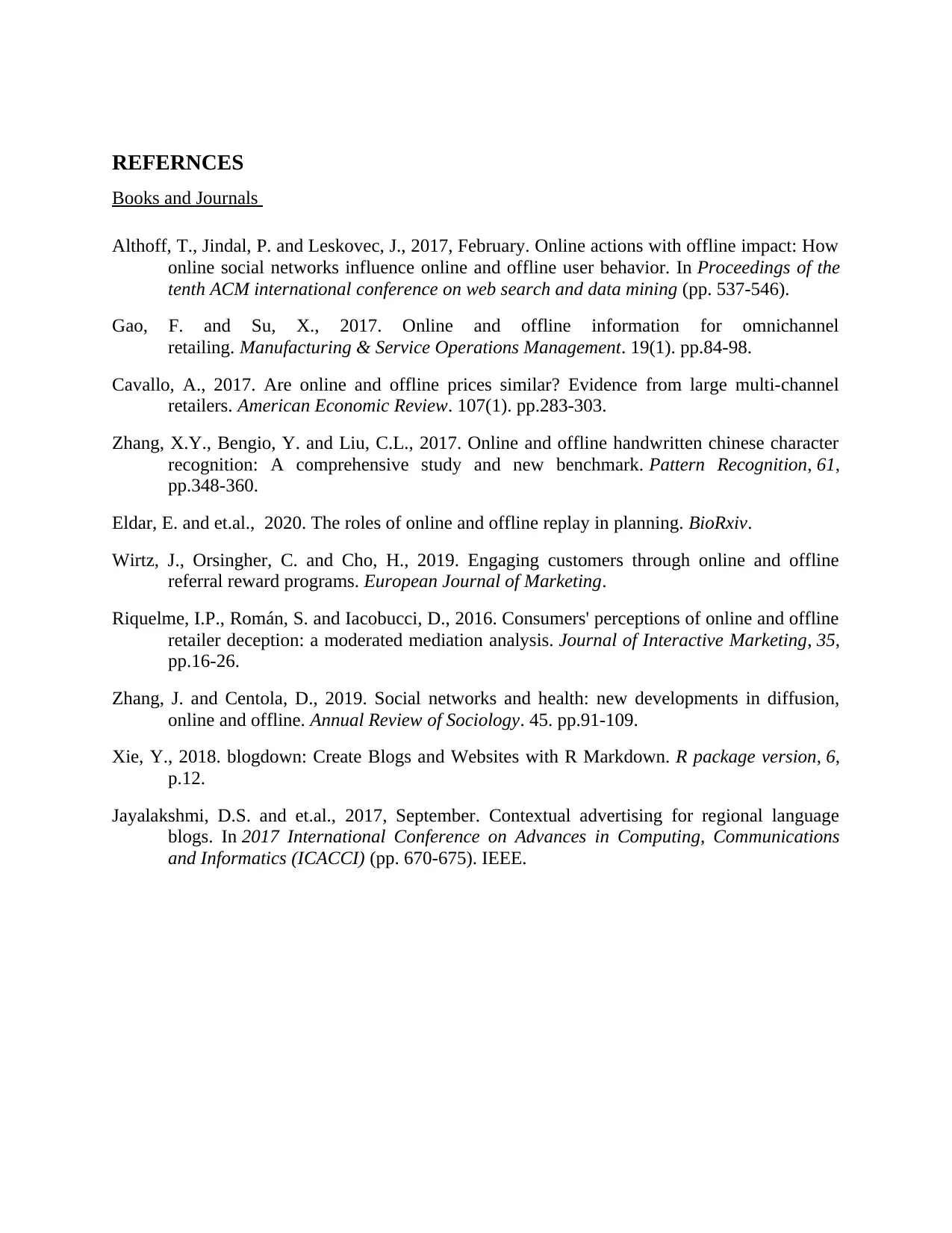
REFERNCES
Books and Journals
Althoff, T., Jindal, P. and Leskovec, J., 2017, February. Online actions with offline impact: How
online social networks influence online and offline user behavior. In Proceedings of the
tenth ACM international conference on web search and data mining (pp. 537-546).
Gao, F. and Su, X., 2017. Online and offline information for omnichannel
retailing. Manufacturing & Service Operations Management. 19(1). pp.84-98.
Cavallo, A., 2017. Are online and offline prices similar? Evidence from large multi-channel
retailers. American Economic Review. 107(1). pp.283-303.
Zhang, X.Y., Bengio, Y. and Liu, C.L., 2017. Online and offline handwritten chinese character
recognition: A comprehensive study and new benchmark. Pattern Recognition, 61,
pp.348-360.
Eldar, E. and et.al., 2020. The roles of online and offline replay in planning. BioRxiv.
Wirtz, J., Orsingher, C. and Cho, H., 2019. Engaging customers through online and offline
referral reward programs. European Journal of Marketing.
Riquelme, I.P., Román, S. and Iacobucci, D., 2016. Consumers' perceptions of online and offline
retailer deception: a moderated mediation analysis. Journal of Interactive Marketing, 35,
pp.16-26.
Zhang, J. and Centola, D., 2019. Social networks and health: new developments in diffusion,
online and offline. Annual Review of Sociology. 45. pp.91-109.
Xie, Y., 2018. blogdown: Create Blogs and Websites with R Markdown. R package version, 6,
p.12.
Jayalakshmi, D.S. and et.al., 2017, September. Contextual advertising for regional language
blogs. In 2017 International Conference on Advances in Computing, Communications
and Informatics (ICACCI) (pp. 670-675). IEEE.
Books and Journals
Althoff, T., Jindal, P. and Leskovec, J., 2017, February. Online actions with offline impact: How
online social networks influence online and offline user behavior. In Proceedings of the
tenth ACM international conference on web search and data mining (pp. 537-546).
Gao, F. and Su, X., 2017. Online and offline information for omnichannel
retailing. Manufacturing & Service Operations Management. 19(1). pp.84-98.
Cavallo, A., 2017. Are online and offline prices similar? Evidence from large multi-channel
retailers. American Economic Review. 107(1). pp.283-303.
Zhang, X.Y., Bengio, Y. and Liu, C.L., 2017. Online and offline handwritten chinese character
recognition: A comprehensive study and new benchmark. Pattern Recognition, 61,
pp.348-360.
Eldar, E. and et.al., 2020. The roles of online and offline replay in planning. BioRxiv.
Wirtz, J., Orsingher, C. and Cho, H., 2019. Engaging customers through online and offline
referral reward programs. European Journal of Marketing.
Riquelme, I.P., Román, S. and Iacobucci, D., 2016. Consumers' perceptions of online and offline
retailer deception: a moderated mediation analysis. Journal of Interactive Marketing, 35,
pp.16-26.
Zhang, J. and Centola, D., 2019. Social networks and health: new developments in diffusion,
online and offline. Annual Review of Sociology. 45. pp.91-109.
Xie, Y., 2018. blogdown: Create Blogs and Websites with R Markdown. R package version, 6,
p.12.
Jayalakshmi, D.S. and et.al., 2017, September. Contextual advertising for regional language
blogs. In 2017 International Conference on Advances in Computing, Communications
and Informatics (ICACCI) (pp. 670-675). IEEE.
1 out of 10
Related Documents
Your All-in-One AI-Powered Toolkit for Academic Success.
+13062052269
info@desklib.com
Available 24*7 on WhatsApp / Email
![[object Object]](/_next/static/media/star-bottom.7253800d.svg)
Unlock your academic potential
Copyright © 2020–2025 A2Z Services. All Rights Reserved. Developed and managed by ZUCOL.





